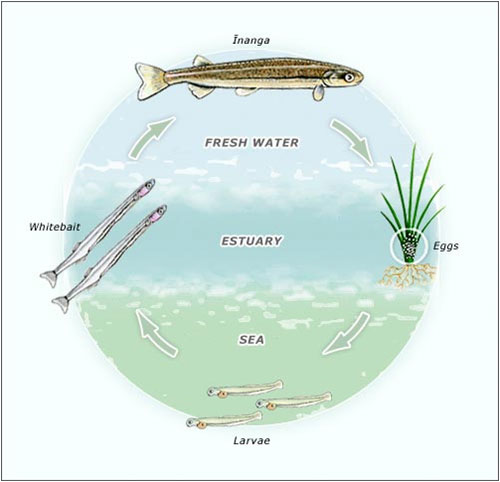 Inanga (Galaxias maculatus)
Inanga (Galaxias maculatus)
From the Department of Conservation website
Whitebait catch consists primarily of the young of three species: īnanga (Galaxias maculatus), kōaro (G. brevipinnis) and banded kokopu (G. fasciatus); īnanga is by far the most commonly caught species.
Giant kokopu (G. argenteus), short-jawed kokopu (G. postvectis) and smelt (Retropinna retropinna) are also occasionally present along with the young of many other fish such as eels, bullies and trout.
Find out how to identify whitebait here
All whitebait species spend part of their life cycle in fresh water and part in the sea. Tiny fish hatch in late autumn and are carried along rivers out to sea where they live and grow over the winter.
In late winter and early spring whitebait migrate back up rivers and streams, finally settling and growing in bush covered streams and swamps. The start of the migration is thought to be influenced by river flows (i.e. shortly after floods) and phases of the moon.
 Mature īnanga adults migrate downstream to lower river sections and estuaries to spawn in grasses covered by water during spring tides. The eggs remain in the grass until the next spring tide covers them again when the young hatch and are carried out to sea. The spawning habits of other whitebait species are not well known.
Mature īnanga adults migrate downstream to lower river sections and estuaries to spawn in grasses covered by water during spring tides. The eggs remain in the grass until the next spring tide covers them again when the young hatch and are carried out to sea. The spawning habits of other whitebait species are not well known.
Physical habitats
The five galaxiid species are found in many different habitats from lowland swamps to rocky streams. Their presence appears to be closely tied to overhead cover and waterside vegetation.
Giant kokopu live in swampy and heavily vegetated streams, often in pools over a mud bottom. Short-jawed kokopu, banded kokopu and koaro prefer fast flowing rocky or boulder bottomed streams with forest cover. Īnanga are less "fussy" but are generally found in lower catchment waters.
One of the major problems affecting the whitebait fishery is the destruction of habitat for egg laying or adult fish. As whitebait adults tend to live in natural swamps and bush covered streams it is in the best interest of whitebaiters to ensure that adequate areas of these habitats remain.
The Department of Conservation has been active in identifying whitebait spawning habitat and arranging for its protection. Protection has involved seeking the co-operation of landowners to have spawning areas fenced off from stock. The Department sees the protection of whitebait spawning habitat as playing a major role in enhancing the lasting viability of the fishery.
Another major problem is barriers that stop young fish from getting to adult habitat.
Please note that whitebait are native fish and the giant and short-jawed kokopu are under threat in many areas.
Your assistance in keeping the whitebait fishery healthy not only benefits you, but the health of New Zealand's natural living systems. Don't take more than you need.
Further reading
You can find more information about whitebait in the following publications:
McDowall R.M. (1990): New Zealand Freshwater Fishes - A natural history and guide. Heinemann Reed, Auckland. McDowall R.M. (1984): The New Zealand Whitebait Book. Reed Wellington (re-printed 1992).
Images by Stephen Moore
